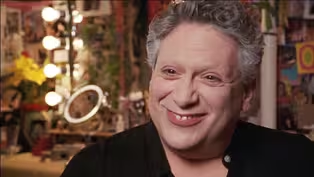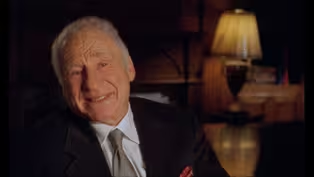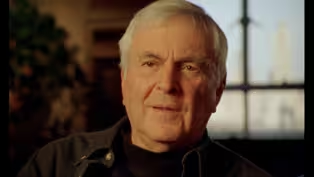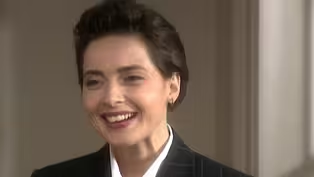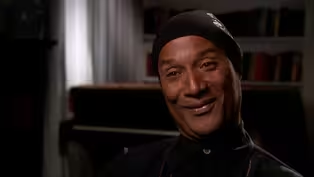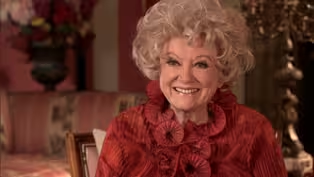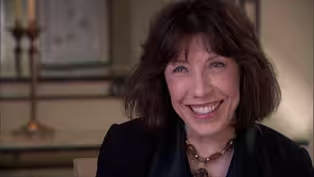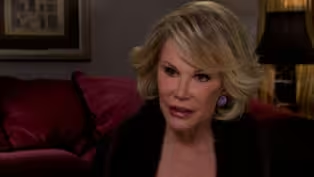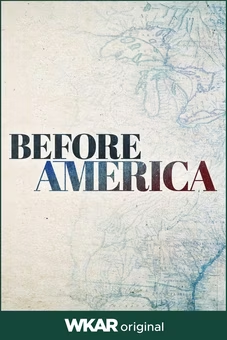
Baayork Lee on becoming a Broadway star at age 5
Special | 12m 24sVideo has Closed Captions
Baayork Lee discusses starring on Broadway at age 5 and working with Richard Rodgers.
On January 17, 2001, actress and dancer Baayork Lee discussed landing her first role on Broadway at age 5, working with Richard Rodgers and other Broadway greats, and her passion for choreography. Interview conducted for "American Masters: Richard Rodgers: The Sweetest Sounds" (2001), directed by Roger Sherman.
Problems playing video? | Closed Captioning Feedback
Problems playing video? | Closed Captioning Feedback
Support for American Masters is provided by the Corporation for Public Broadcasting, AARP, Rosalind P. Walter Foundation, Judith and Burton Resnick, Blanche and Hayward Cirker Charitable Lead Annuity Trust, Koo...

Baayork Lee on becoming a Broadway star at age 5
Special | 12m 24sVideo has Closed Captions
On January 17, 2001, actress and dancer Baayork Lee discussed landing her first role on Broadway at age 5, working with Richard Rodgers and other Broadway greats, and her passion for choreography. Interview conducted for "American Masters: Richard Rodgers: The Sweetest Sounds" (2001), directed by Roger Sherman.
Problems playing video? | Closed Captioning Feedback
How to Watch American Masters
American Masters is available to stream on pbs.org and the free PBS App, available on iPhone, Apple TV, Android TV, Android smartphones, Amazon Fire TV, Amazon Fire Tablet, Roku, Samsung Smart TV, and Vizio.
Buy Now
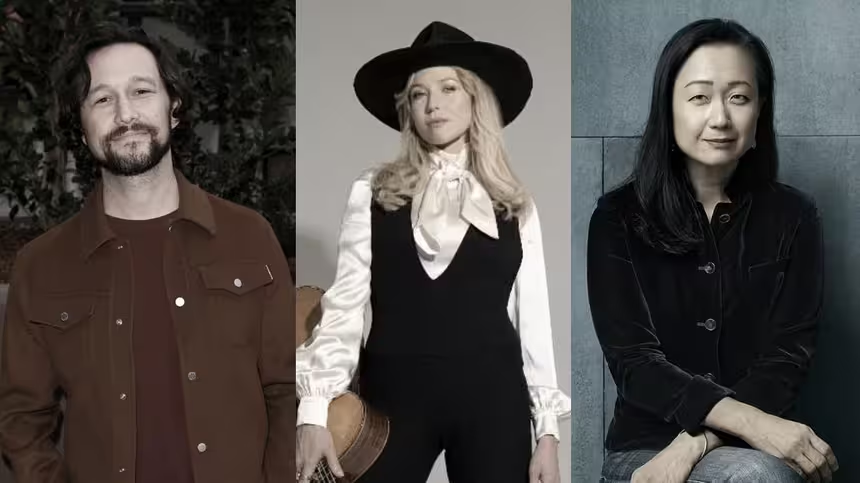
A front row seat to the creative process
How do today’s masters create their art? Each episode an artist reveals how they brought their creative work to life. Hear from artists across disciplines, like actor Joseph Gordon-Levitt, singer-songwriter Jewel, author Min Jin Lee, and more on our podcast "American Masters: Creative Spark."Providing Support for PBS.org
Learn Moreabout PBS online sponsorshipMore from This Collection
Watch curated interviews from The American Masters Digital Archive. The full collection includes over 1,000 hours of never-before-seen, raw interviews: a treasure trove of the movers and shakers of American culture, including Maya Angelou, Patti Smith, Mel Brooks, Carol Burnett, Matthew Broderick, Carl Reiner, Joan Rivers, Dionne Warwick, Lee Grant, Sidney Lumet, Betty White and many others.
Harvey Fierstein on gay representation on Broadway and its deep history
Video has Closed Captions
Harvey Fierstein talks to director Michael Kantor backstage during the production of "Hairspray." (13m 8s)
Video has Closed Captions
Ringo Starr describes his friendship with Mae West. (10m)
Mel Brooks' wild ride to his first Broadway show ever
Video has Closed Captions
Mel Brooks talks about the first Broadway show he ever saw—Cole Porter's "Anything Goes." (5m 44s)
John Kander and Fred Ebb on “Cabaret,” creativity and collaboration
Video has Closed Captions
Composer John Kander and lyricist Fred Ebb talk about how they have worked together. (5m 56s)
Isabella Rossellini compares her acting and modeling
Video has Closed Captions
Isabella Rossellini discusses her acting versus modeling career. (28m 24s)
Quincy Jones explains how he got started in music
Video has Closed Captions
Quincy Jones discusses his early career, friendships and how he defines himself. (15m)
Paul Mooney on his career and relationship with Richard Pryor
Video has Closed Captions
Paul Mooney reflects on the mechanics of stand-up and his role as Richard Pryor's best friend. (10m 39s)
How Phyllis Diller broke down the doors for female comics
Video has Closed Captions
Phyllis Diller reflects on how her comedy was a response to years of “take my wife” jokes. (11m 35s)
How Lily Tomlin found liberation in exploring her Laugh-In characters
Video has Closed Captions
Lily Tomlin speaks about her time on Laugh-In and how she developed her characters. (12m 35s)
Jeff Foxworthy on how every American might be a "redneck"
Video has Closed Captions
Jeff Foxworthy discusses regionalism in comedy and why "redneck" is a state of mind. (15m 41s)
Joan Rivers finds humor in being yourself
Video has Closed Captions
Joan Rivers speaks about her experience as a female comic in the early 60s. (9m 59s)
Conan O’Brien gets serious about silliness
Video has Closed Captions
Conan O’Brien speaks about his style of late night and his reason for doing comedy. (15m 32s)
Providing Support for PBS.org
Learn Moreabout PBS online sponsorship- I started dancing at the age of three, at the Katherine Dunham School.
And at the age of five, the casting people for "King and I" went to Chinatown looking for children.
And so we all came up on the train, with our mothers, and we went to the audition and there were hundreds and hundreds of children there.
But the next day I saw my photograph in the paper with, you know, like 300 kids and I was in the front and I got the show.
I also had to read and I didn't know how to read lines, so my mother had to feed them to me, but I did get the role of Princess Ying Yaowalak, at five.
Most of the kids were professional.
They went to professional children's school.
They had been in shows.
I don't know where they came from, but, you know I always felt like an outsider, because I had never done anything, but they got it.
And so it was up to me to get it, because I did not wanna be left behind.
And it wasn't intricate choreography.
The thing that fascinated me was, "The Small House of Uncle Thomas" and that's what I wanted to do.
And I used to watch the girls, the dancers warm up and I would ask my mother to speak to them and ask them where I could learn that.
And Lee Theodore and Yuriko had gone to Martha Graham, a Balanchine school, and that really influenced my decision, at five, to have a career as a dancer.
And I was on track.
I didn't wanna do anything else.
That's what I wanted to do.
So, Richard Rogers's music, Jerome Robbins's dancing, those two combined really influenced me.
Being on stage was very easy for me.
I learned everybody's lines.
I knew everybody's dances.
I even learned "Small House of Uncle Thomas" and we put on shows upstairs on the eighth floor, at the St. James Theater.
And I played all the parts and I directed everybody.
So I was directing and choreographing at five.
(giggling) I just remember seeing those people out there that made the decisions to change things or tell us what to do.
And I was always interested in what was going on out there.
And it was Richard Rogers and Oscar Hammerstein and John Van Ruiten.
And they directed me.
And I didn't know what it was to be directed by great people.
I just knew that I was doing the best that I could do.
And it was a big game and I loved it.
"The Small House of Uncle Thomas" was written by Harriet Beecher Stowe, that's how they say it in the show.
And they took the novel and it's about a runaway slave.
And they turned it into an Asian theme, where Eliza runs away from Simon of Legree.
And it, once again, the storytelling and the dance and the combination of the two has really helped me in my choreographing and making sure that I really tell the story.
"The Small House of Uncle Thomas" was the performance that Top Tim gives to the English that have arrived in Bangkok.
And it fascinated me, because it was storytelling and then the dance and that has influenced me also.
Always tell your story in your dance.
Agnes de Mille also had done that in "Oklahoma."
She had her leading characters, she danced their fears and their desires in the "Dream Ballet."
All of that, it's all back in my memory, but it has really influenced me in my choreography.
"The Small House of Uncle Thomas," the moves were wonderful.
Jerome Robbins combined his dancing, with the Balinese dancing and Yuriko, who had been Martha Graham's leading dancer, she was the lead.
It was so fascinating being around all of this talent.
And we lived, we say "lived" because that's where they put us, on the eighth floor.
They would allow a few of us to come down and watch.
And I would imitate the moves.
And finally, one of the girls became the Buddha and she could watch the choreography and we danced it.
We lived it.
I loved that show.
I really did.
I was in "King and I" for two and a half years.
I outgrew my costume and I was one of the first to leave.
And that was heartbreaking.
Richard Rogers, I don't, I was so young.
I didn't, I knew him as Mr. Rogers.
He always came around, but I didn't really know who he was.
And what he had written.
I knew he was the composer, but what did composers do?
But he was always around and everyone loved the children.
The original cast, they always kept in touch with us afterwards, also, sending us cards and things like that.
After three years, or two and a half years being in "The King and I," and I walked down the street and I looked back and I said, "I'll be back."
Well, a few years later there was an audition for "Flower Drum Song."
And so I told my mother, "I've gotta go, I've gotta go, I've gotta go."
And in the meantime, I had been taking dance and there was a big audition for children, as well as dancers, and we are back at the St. James Theater, in the alley again.
And I went in and I think they had about 10 or 15 children walk in and stand on stage.
And I was eliminated and I was crushed.
And as I was leaving, practically in tears, Mr. Rogers and Mr. Hammerstein walked into the theater.
And I said to my mother, "I'm going back in.
They'll remember me.
They'll remember me."
And so I got past the monitor and I was put on stage again and I heard this voice, "Baayork Lee, step out."
And it was Mr. Rogers.
And we started talking and he said, "Gosh, you've grown."
And I had gotten taller.
And the next day I was in the papers with he and Mr. Hammerstein.
And I had gotten the show.
So he was responsible for me getting into "Flower Drum Song."
And then, because I was in the other generation, I could not be in "Fan Tan Fannie", because they were strippers, but they needed a cover for Anita Ellis to sing "Fan Tan Fannie."
And I loved Pat Suzuki.
And so I bought all of her albums and I would sing like her all the time.
And because of that, I got the cover to Anita Ellis, in "Fan Tan Fannie, Mr. Rogers gave that to me.
"Flower Drum Song" is about the older generation and the young Oriental-American generation trying to break away and become Americans.
And the older generation just still bringing the old country and the old ideas to America.
I'm still going through that now, so it, I think it's wonderful that they tackled the subject.
It needed to be addressed.
- [Interviewer] Talk about what had changed in those eight years, in Broadway, in musicals.
Had anything changed?
What was the buzz about "Flower Drum Song"?
What was different about Broadway?
- Being Asian at the time was really important, because we had "Majority of One," "Flower Drum Song," and "Suzie Wong" across the street.
Three shows that had Asians in it or American Orientals, whatever we were called in those days.
I think that was really very important.
It has changed now.
We have Pan Asian Theater, but for so many years, there was nothing for American Chinese, American Asian.
I'm hoping that "A Chorus Line" and my part has helped to give short little Chinese girls some work.
Mr. Rogers's music is definitely danceable.
And, why?
Because I think, more than anybody else, he really got into the soul of the dance and the choreographer while he was writing it.
Movement is so easy with his music.
You don't have to struggle.
Your body just responds to it.
And choreographing is not always easy, but I think it's easy with his music.
When you walk in a room and you have a Rogers score, as a dancer and as a choreographer, I think he gets to the soul of the dancer, of the choreographer.
The music allows you to be free.
There's nothing that limits you with his music.
- [Interviewer] Close your eyes for a second and think of the great choreography that you've seen, that Balanchine might have done, or de Mille, or Robinson.
Describe one of those.
Give us an example of why it's so soaring, so wonderful.
- "The Dream Ballet" and "Oklahoma."
Every single character that she portrayed, every single movement that she gave those dancers, you live with them through her choreography.
And that's what I wanna do when I choreograph.
I want my dancers to live the choreography, live the moment, live the scene, live the dialogue.
When all of those elements are in place, the audience breathes with what's happening on the stage, or they stop breathing, hopefully.
And that's what we want them to do.
We want them to just live and breathe with us every single second.
Support for PBS provided by:
Support for American Masters is provided by the Corporation for Public Broadcasting, AARP, Rosalind P. Walter Foundation, Judith and Burton Resnick, Blanche and Hayward Cirker Charitable Lead Annuity Trust, Koo...

